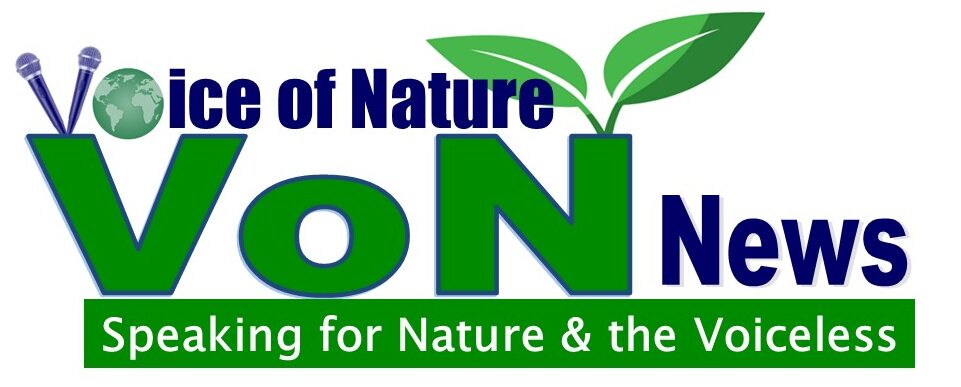Kids and young adults hold the key to the future conservation of great apes and other endangered species around the world. They will be the ones to make decisions and enact laws in the future regarding the conservation of natural resources but most of them are today more exposed to television and smartphones than nature and endangered species. This is further compounded by the fact that they are often left out of most conservation efforts and actions, casting doubts on the future sustainability of great apes and other species. With support from New England Biolabs Foundation, a Cameroon-based biodiversity conservation and sustainable development non-profit organization, Voice of Nature (VoNat), has set out to change this narrative.
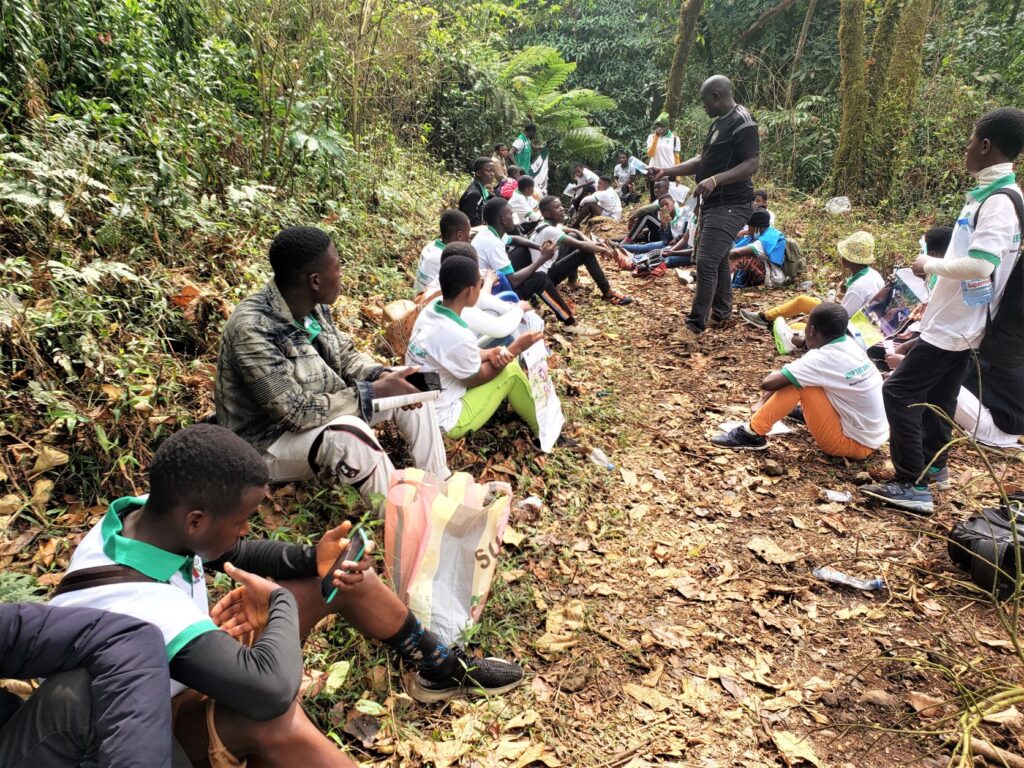
Through the creative use of media & arts, special conservation education sessions, traditional knowledge & belief systems, and wildlife tracking/biomonitoring, VoNat has engaged over 50 community kids and young adults within the Mount Cameroon Area in the conservation of great apes and other endangered species. The youngsters from Bokova, Bova, Bonakanda, Bwitingi, and Bwiteva communities in the Mount Cameroon area are already educating their peers and advocating for species conservation within their communities after going through a 7-month experiential learning session on conserving the endangered ape of Mount Cameroon.
Great Apes Conservation Education
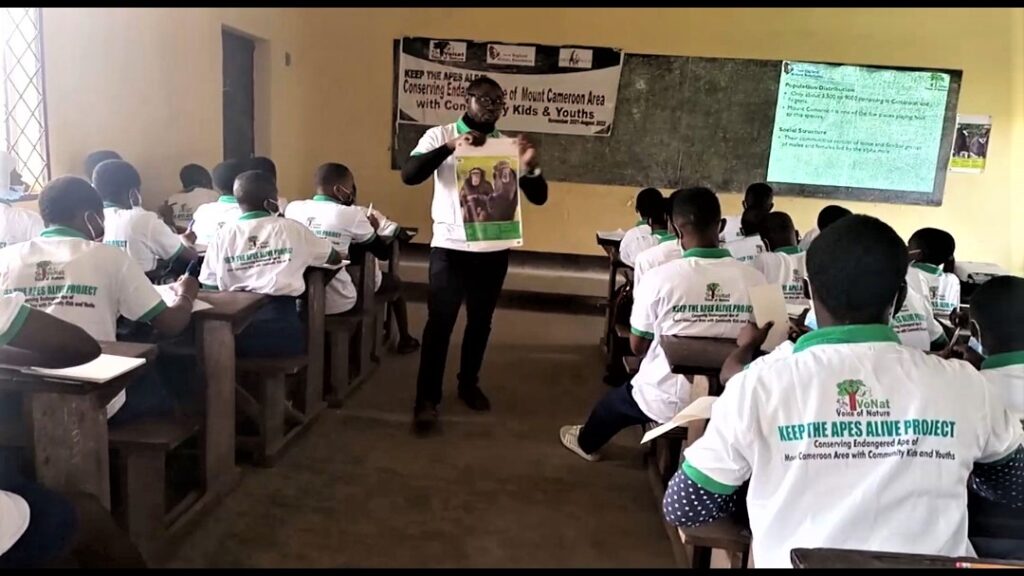
Boosting the interest of community kids and young adults in great apes and other wildlife species conservation is important as attitudes about the earth’s natural resources begin at an early age. In the project; “Conserving Endangered Ape of Mount Cameroon with Community Kids”, VoNat used charts, PowerPoint presentations, great ape photos, and videos to instill in over 50 kids and young adults in the Mount Cameroon Area a fresh zeal to get engaged in conserving the great ape of the Mount Cameroon National Park and other endangered biodiversity species. “I am going to sensitize my parents, friends, and all those going to the bush to hunt endangered species so that the species don’t go into extinction,” Mary Namondo from Bokova village, like many other kids, pledged to be conservation ambassadors in her community and schools, shortly after the conservation education sessions.
The conservation education sessions changed the mindset of many kids about hunting. “In our village, when they hear that you are going to the forest to hunt, they will be proud of you that you are a great man. I did not know that it was a bad practice or something that can affect us in the future given that they play a vital role in sustaining the ecosystem,” Pieres Nakah from Bwitingi village said. These youngsters will grow up as proactive adults concerned about wildlife species and their welfare.
Wildlife Tracking & Biomonitoring
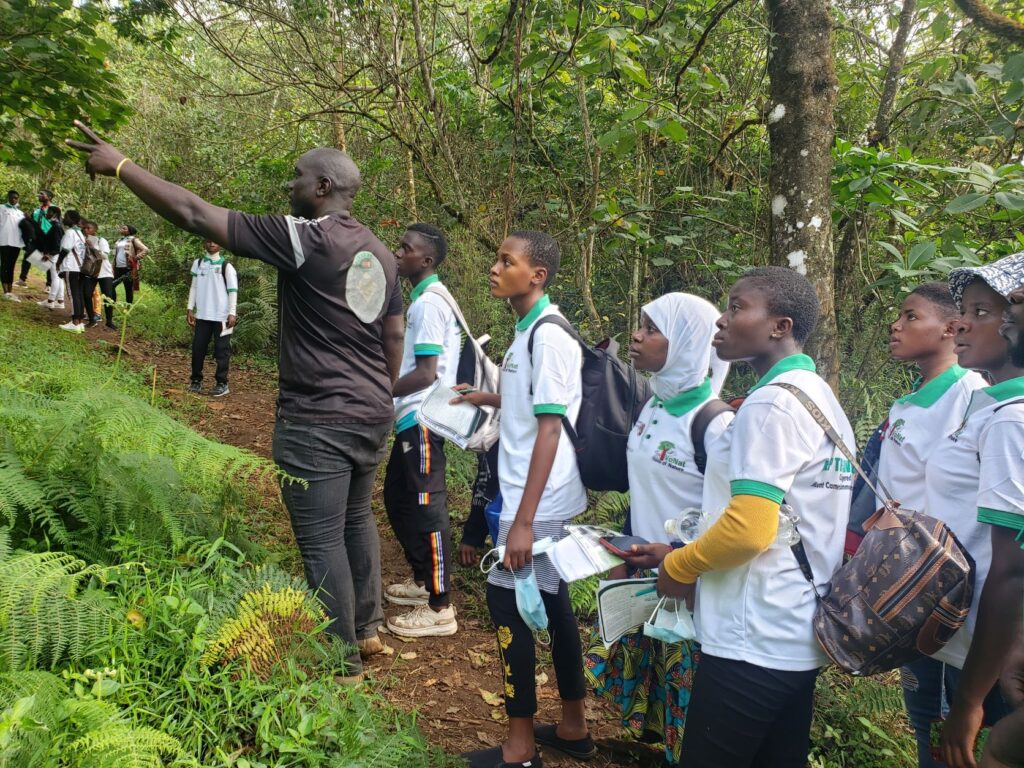
If kids do not feel connected to nature and species, they will not have a desire to protect it. The increasing exposure of kids and young adults to TV, computer, phone or tablet has induced “nature deficit disorder,” requiring a quick fix. Immersing kids in nature and reconnecting them with wildlife species remains the ultimate option. Cognizance of this, In March 2022, VoNat engaged over 40 kids (7 to 18) years from communities in the Mount Cameroon Area in tracking and monitoring wildlife species within the Mount Cameroon National Park.
Under the guidance of the Head of the Research and Biomonitoring Unit of the Mount Cameroon National Park Service, Mr. Esoka Thomas Ngalame, and the technical team of VoNat, the children from Bokova, Bova, Bonakanda, Bwitingi, etc. for over 8 hours moved quietly through this protected area; identifying and recording vital data about wildlife species and conservation threats. These included but not limited to feeding signs, direct observation, vocalization, gun shells, deforestation, bush burning, animal tracks, dungs, footprints etc.
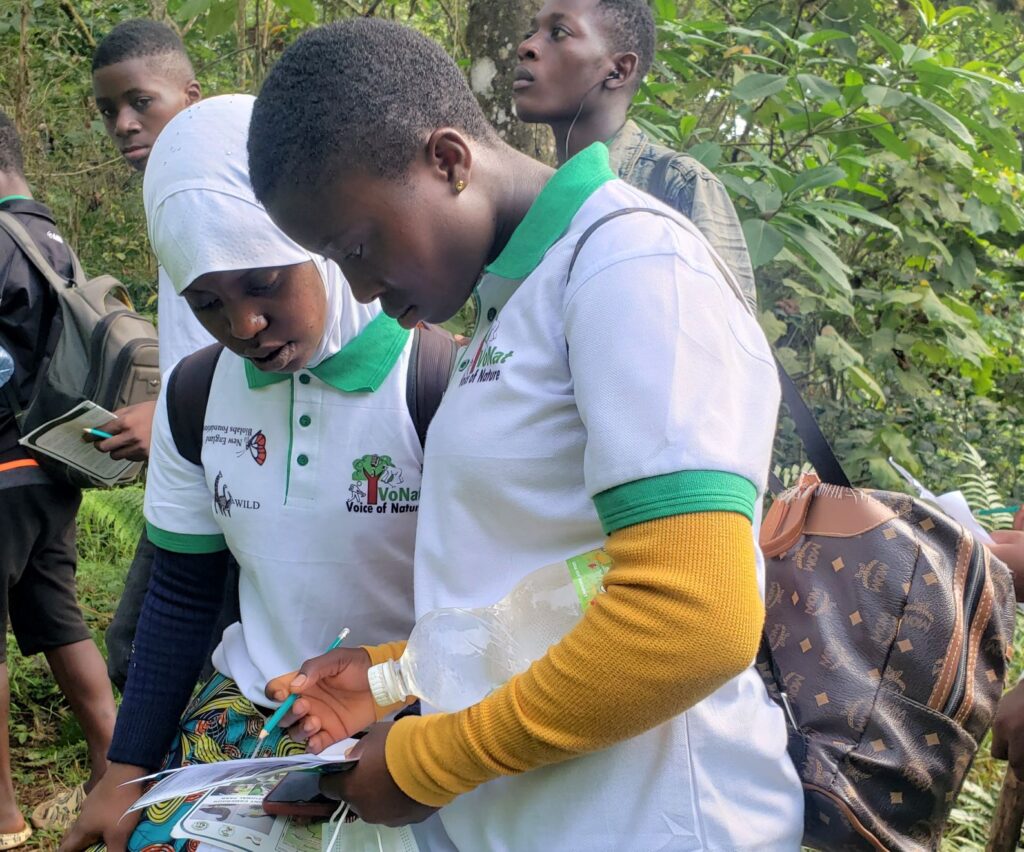
Though living adjacent to the Mount Cameroon National Park, it was the first time for over 90% of the kids to visit this biodiversity hot spot and to be engaged in wildlife tracking and biomonitoring. “I have seen some species of animals today for the first time; I saw birds, signs, a squirrel, a francolin, and also heard the vocalization of many animal species; I saw the track of an antelope,” Zara Buri from Bokova attested. Mbome Theres Nomondo from Bwitingi became connected to nature while carrying out the tracking and biomonitoring exercise. “Honestly speaking, I am here with my friends, it’s so beautiful out here and I don’t feel like going back home. I hope that we will be able to beautify nature and keep these animals saved,” she said.
Pro-conservation traditional knowledge and belief systems
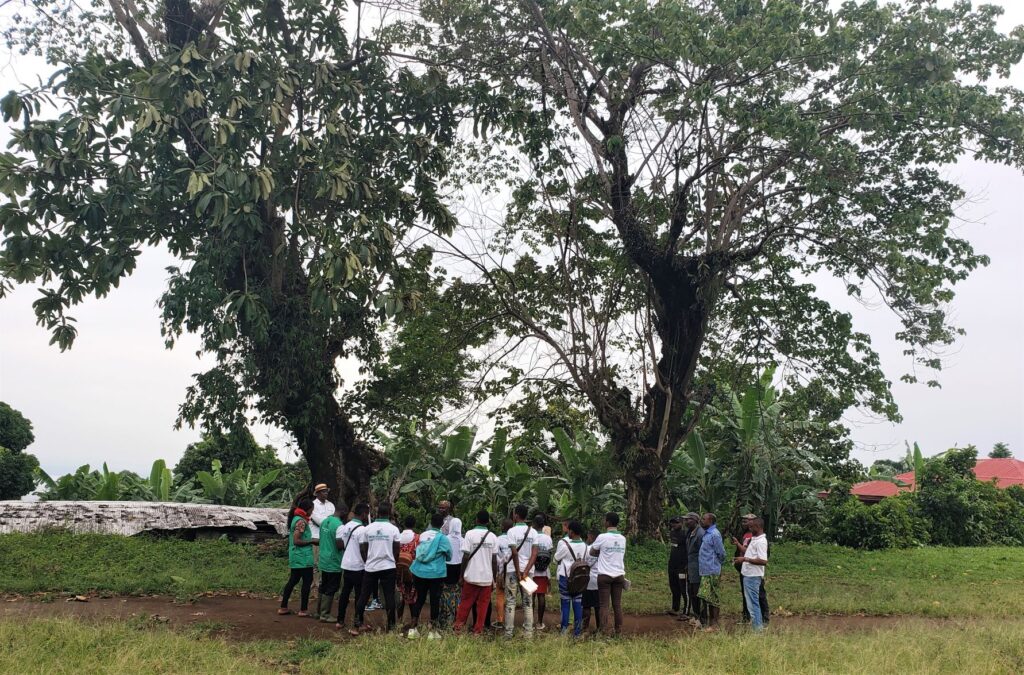 The increasing adoption of western values by community kids and youths has eroded their appetite for the long-standing historical traditional conservation narratives that aided in species conservation before colonialism. Kids and youths, who hold the key to future conservation actions are glued to computer games, TV sets and the social media, regarding most of these pro-conservation beliefs as primitive. This poses a serious threat to the future conservation of this species, requiring urgent actions. To salvage this plight, VoNat recently organized a folktale and pro-conservation traditional belief information gathering session with kids and youths from five communities in the Mount Cameroon Area.
The increasing adoption of western values by community kids and youths has eroded their appetite for the long-standing historical traditional conservation narratives that aided in species conservation before colonialism. Kids and youths, who hold the key to future conservation actions are glued to computer games, TV sets and the social media, regarding most of these pro-conservation beliefs as primitive. This poses a serious threat to the future conservation of this species, requiring urgent actions. To salvage this plight, VoNat recently organized a folktale and pro-conservation traditional belief information gathering session with kids and youths from five communities in the Mount Cameroon Area.
This was organised as part of the project; Conserving Endangered Ape of Mount Cameroon with Community Kids, funded by New England Biolabs Foundation with additional support from Idea Wild. In the Bonakanda community, the traditional ruler, Chief Emmanuel Ndongo Molongo, took the youngsters to a large tree at the center of the village known locally as Mowumba, and told them the traditional and historical link between the Bakweri people and the tree, which makes it difficult for them to cut down the tree. The traditional ruler further thrilled the community kids and youths with stories about chimpanzees and elephant totems. He narrated how an elephant hunter, Pa Mbella, died after attempting to kill a totemic elephant. The traditional ruler took the future conservation leaders to some forest patches and shrines conserved because of traditional beliefs in the Bonakanda community and told stories behind their existence.
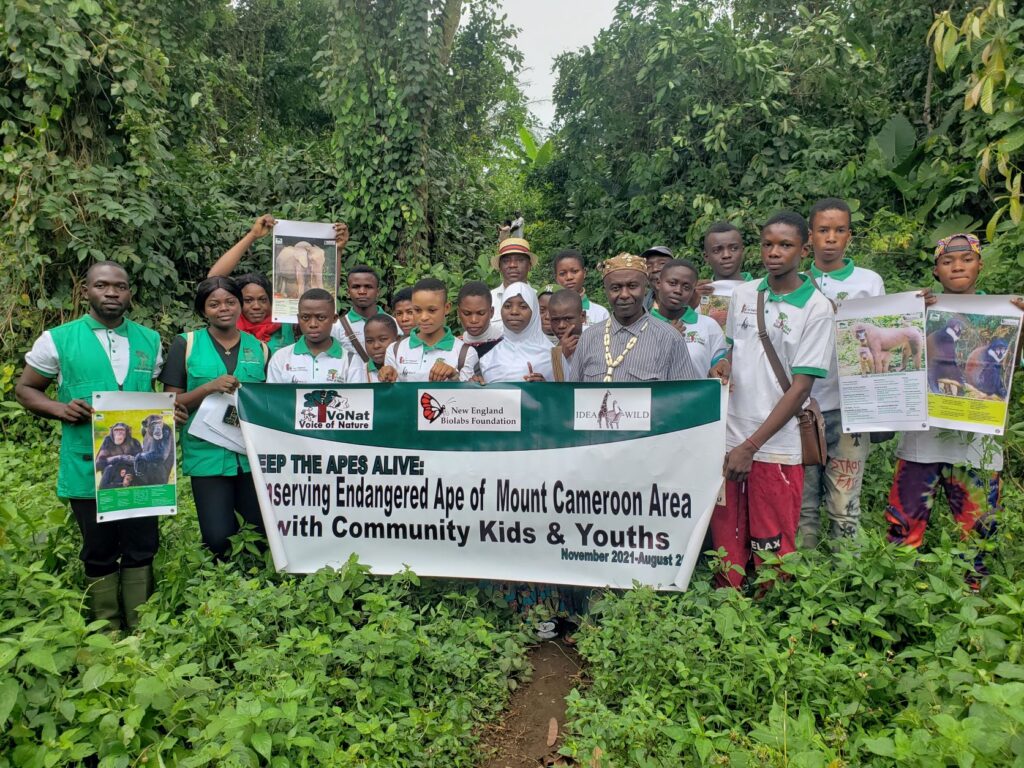
The storytelling sessions aided in transferring some vital traditional knowledge and belief about animals and tree species in the Mount Cameroon Area to the community kids and youths. They were particularly thrilled by the belief in totem. “I learned that some elephants and chimpanzees can be human totems and killing them may lead to the killing of the totem owner. This is interesting knowledge for me, I never knew before. I think these species should be left alive” Emmanuel from Bonakanda said.
Media and Arts for Conservation
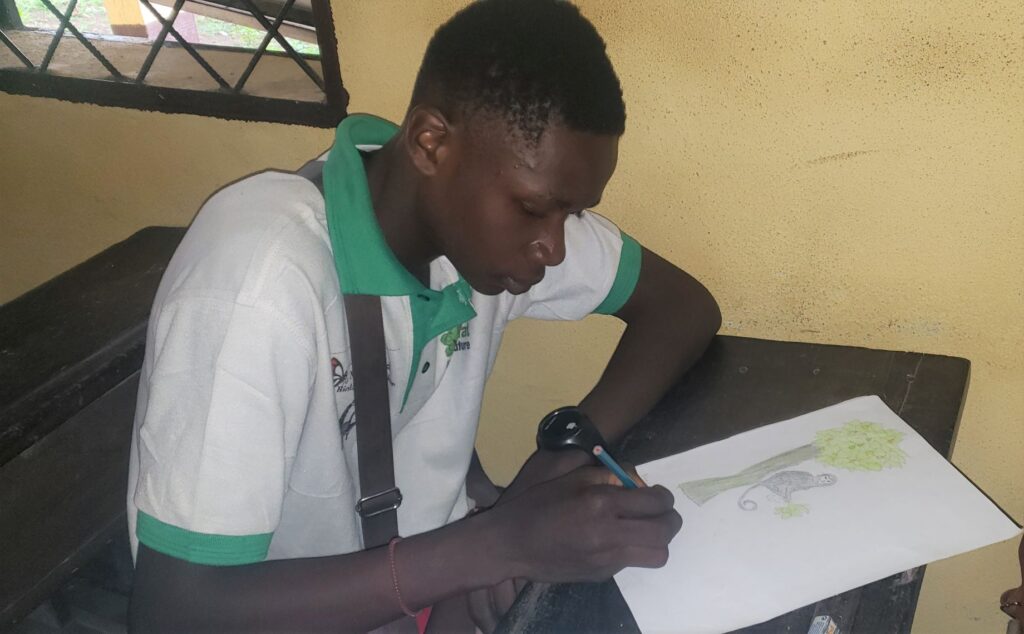
Media and Arts are a powerful tool with a high propensity to communicate and transform the way people think and act. The interplay and creative use of these tools can change dynamics in the perception and promotion of species conservation. In a bid to conserve the endangered ape of Mount Cameroon and other endangered species of this area, community kids and youths leveraged on the hands-on training on media and arts to produce short articles/stories, songs, drawings, and poems on species conservation and traditional knowledge and belief about some local fauna and flora species in their communities. This boosted their appetite in biodiversity conservation and has contributed in preserving pro-conservation traditional knowledge.
